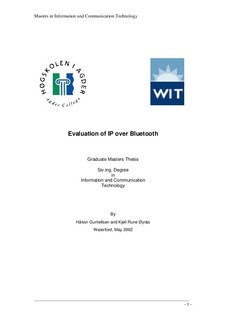| dc.description.abstract | The increasing use of Wireless technologies suggest that this kind of technology has a
bright future. Today the most popular Wireless Local Area Networks are WLAN
802.11 and Bluetooth. They both have their strengths in different environments.
Bluetooth was not initially an Internet technology, but over the years the focus on
implementing Bluetooth nodes with Internet capability has increased. When we want
to run IP over Bluetooth we need some kind of gateway to the Internet from
Bluetooth, a network access point. This will be an important device in the thesis. The
Bluetooth Special Interest Group has suggested two ways to implement IP over
Bluetooth in different scenarios, but there is still a lot more work to do. This thesis
will deal with some of these approaches. Hence, we will discuss problems like: the
Bluetooth protocol stack, scalability, efficiency and mobility, which are the factors
considered important to Bluetooth and IP.
The thesis will give an evaluation of these different issues and in the end we will give
a short outline of how we suggest making a larger Bluetooth network which runs over
IP.
The Stack – There has been several suggestions about how to implement IP over
Bluetooth. We have taken a look at four different designs of the Bluetooth stack and
evaluate all of them. There are mainly two designs that are relatively good and can
both be used. We will give preference to these two methods and their strengths and
weaknesses.
Scalable – The number of Bluetooth devices within one single Bluetooth-network is
currently quite limited (piconets). But according to the Bluetooth specification we can
interconnect several networks (scatternets). It has not yet specified how to realize IP
over Bluetooth, but there is work going on. If we had a network like this, the network
will become more complex and slow, and maybe that’s the reason this is not
specified. We will evaluate why this is so and suggest ways to make larger Bluetooth
networks more efficient.
Efficient – At the moment Bluetooth networks are relatively slow. The Bluetooth
network is not made for high bit rate transmissions, but still there is some need for a
certain bandwidth. By making a good designed protocol stack and a good network
structure, we will try to make Bluetooth as efficient as possible.
Mobility – As a part of every wireless technology, we always set some requirements
for roaming and mobility. We want Bluetooth devices to roam and connect to the
nearest Internet access point. Issues we will need to discuss concerning this topics are
methods to realize a well designed network that covers the needs of Bluetooth
roaming. Some methods we will discuss are Mobile IP, handover/handoff etc.
In this context routing and forwarding is also important matters. In the end we will
also show our own solution to solve mobility problems. | en |
